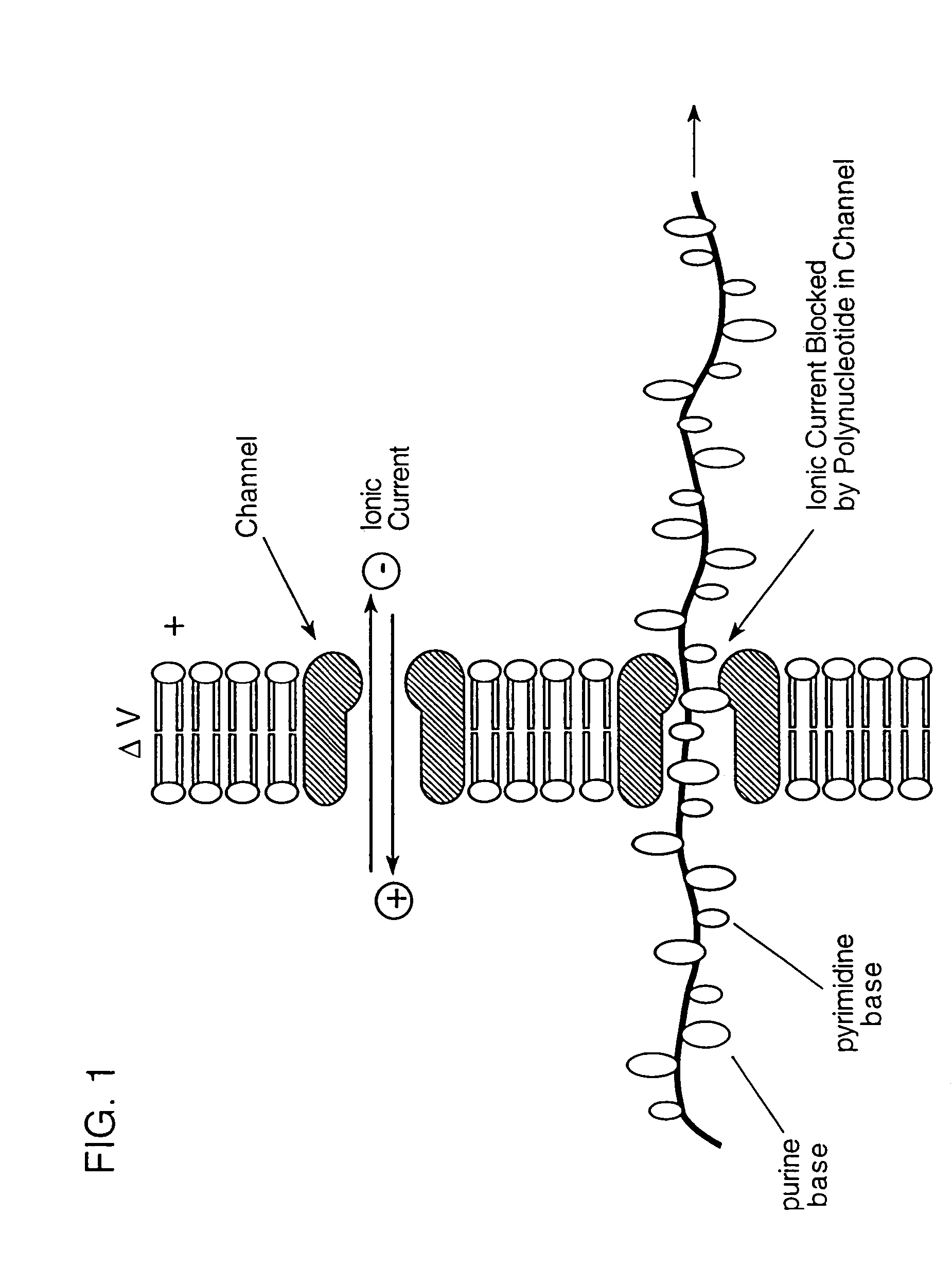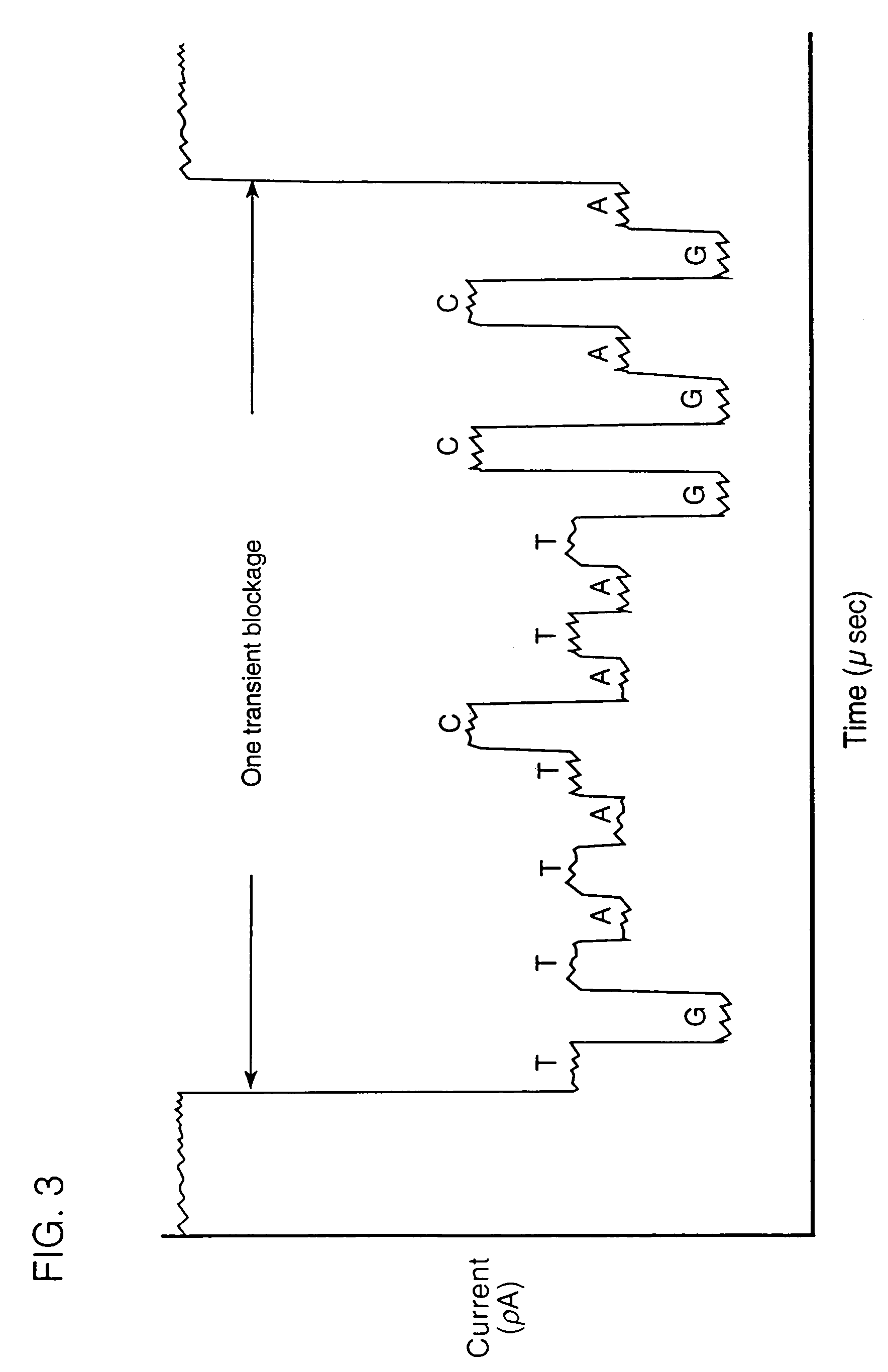Characterization of individual polymer molecules based on monomer-interface interactions
a monomer and interface technology, applied in the field of polymer characterization, can solve the problems of tedious, repetitive work, and the technology of separating and identifying the different length strands, and achieve the effects of reducing the number of sequencing steps, increasing the length of the polymer to be sequenced, and increasing the speed of sequencing
- Summary
- Abstract
- Description
- Claims
- Application Information
AI Technical Summary
Benefits of technology
Problems solved by technology
Method used
Image
Examples
example 1
Conductance Measurements of Lambda DNA Injection
[0100]Bacteriophage lambda injects its DNA through the LamB pore at a rate of about 1000 bp / sec (Novick et al., 1988, Biochemistry, 27:7919–24). Lambda will inject its DNA into liposomes reconstituted with purified E. coli LamB protein. Alcohol or chloroform may be useful in this system (Randall-Hazelbauer and Schwartz, 1973, supra), but if the solvents disrupt current recordings, one can use either the LamB protein from a closely related species, e.g., Shigella sonnei 3070, which allows spontaneous lambda DNA injection into liposomes (Schwartz et al., 1975, J. Virol., 15:679–85; Roessner et al., 1983, J. Biol. Chem., 258:643–48), or a hybrid protein containing portions of LamB from both species, which behaves similarly (Roessner et al., 1987, J. Mol. Biol., 195:963–66).
[0101]The conductance of single LamB pores is monitored during the addition of phage to the medium bathing the bilayer. An initial change in conductance upon phage bind...
example 2
Conductance Measurements of Pore-Polymerase Complexes
[0103]Alternatively, the pore makes use of a polymerase molecule to pass DNA over the pore's opening one base pair at a time. Nucleotide bases of DNA will affect ion flux through the pore as they are passed over it by the polymerase, and the corresponding conductance fluctuations can be detected by high resolution single-channel recording techniques. The polymerase is held in position at the pore's surface as part of a fusion protein with the pore (see FIG. 2).
[0104]Fusion proteins are constructed (e.g., LamB and T7 RNA polymerase) such that both pore and polymerase are functional. The permissive sites in LamB (or any other desired pore protein) that can accommodate insertion of polypeptide sequences without significantly disrupting pore properties are targeted for these fusions. Accommodation of an entire active protein has been demonstrated for E. coli membrane proteins (Boyd et al., 1987, Proc. Natl. Acad. Sci. USA, 84:8525–29;...
example 3
Testing Pore Fusions
[0108]The above system can be tested with a short oligonucleotide containing the T7 RNA polymerase promoter attached to phage T4 DNA that is asymmetrically modified at C residues with oligoglucose chains. The oligonucleotide template is made with the modified bases on the displaced strand, because T7 RNA polymerase has been shown to function when nucleotide analogs are present on this strand (Nath et al., 1991, Carcinogenesis, 12:973–76). The conductance of pore-polymerase complexes is monitored while adding this template and ribonucleotide triphosphates (NTPs) to the system. By adding the NTPs sequentially, one can sample the polymerase at four positions relative to the start site. This provides conductance information pertaining to the modified cytosine closest to the promoter at several distances from (and orientations to) the pore. By adding all four NTPs, the effects of each modified base as it passes the pore can be sampled during RNA synthesis.
[0109]The co...
PUM
| Property | Measurement | Unit |
|---|---|---|
| diameter | aaaaa | aaaaa |
| diameter | aaaaa | aaaaa |
| voltages | aaaaa | aaaaa |
Abstract
Description
Claims
Application Information
 Login to View More
Login to View More - R&D
- Intellectual Property
- Life Sciences
- Materials
- Tech Scout
- Unparalleled Data Quality
- Higher Quality Content
- 60% Fewer Hallucinations
Browse by: Latest US Patents, China's latest patents, Technical Efficacy Thesaurus, Application Domain, Technology Topic, Popular Technical Reports.
© 2025 PatSnap. All rights reserved.Legal|Privacy policy|Modern Slavery Act Transparency Statement|Sitemap|About US| Contact US: help@patsnap.com



